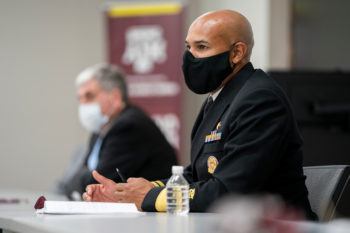Top U.S. Health Officials Visit With Texas A&M Leaders And Students, Tour Vaccine Facility On Campus

Two high ranking U.S. health officials met Monday with Texas A&M University President Michael K. Young, several top administrators and four students to discuss innovations and issues related to COVID-19.
U.S. Department of Health and Human Services Deputy Secretary Eric Hargan and U.S. Surgeon General Jerome Adams also visited Fujifilm Diosynth Biotechnologies, a large-scale vaccine manufacturing facility on the A&M campus. Adams said the facility will be able to put out “20 million doses of vaccine at a time.”
Hargan and Adams, who are touring multiple sites around Texas, said Americans are on the cusp of having a safe and effective vaccine, but need to continue to try and slow the spread of the virus that has taken more than 200,000 lives in the U.S. Bringing together experts from different fields like the military and government, academia and the private sector is what it will take to overcome the pandemic, Adams said.
“I hope that the American people and people of Texas really understand why we’re optimistic,” Adams said at a press conference. “We’re not foolishly optimistic. We are optimistic because we can literally see the products of not only their taxpayer dollars but the products of their investments in these mitigation measures.”
Hargan said that four different vaccines are in phase three trials, and there is a “strong likelihood” that substantial quantities of a safe and effective vaccine will be available by the end of the year or beginning of 2021. He credits this to investment in manufacturing capacity.
“Exactly what’s happening here is the reason why were going to be able to move without delay to manufacturing once the FDA has declared that we have a safe and effective vaccine,” Hargan said.
Both officials also urged everyone to get a flu vaccine soon. Only about 50 percent of adults are vaccinated against the flu annually, Adams said, which he’d like to see pushed closer to 70-80 percent in the future.
He also offered a message to young people about the importance of following public health guidelines during the pandemic.
“We all know that the risk is lower to you for this virus than what it is to older adults. But low risk doesn’t mean no risk,” Adams said. “What I really want you to understand is if you get this virus, you may not die — you probably won’ die. But you could take it home to your grandmother, your grandfather, your loved one,and they could ultimately get sick, get hospitalized and die from this virus. So please, be careful. If you can wear a mask, wash you hands and maintain some degree of social distance and keep your grandmother or someone else’s grandmother from ending up in the hospital or worse, then why not?”
Public health was at the forefront of their conversations, including at the Center for Innovation in Advanced Development and Manufacturing at A&M’s Health Science Center and later at a roundtable discussion with university leadership, students and U.S. Rep. Bill Flores, R-Bryan.
Students who took part in the conversation included Yarielka Arrieta Batista, who is working on her master of public health; Andy Castro, a doctoral student at A&M’s College of Veterinary Medicine & Biomedical Sciences who also is earning a master’s degree in public health; Jordan Garcia, a doctor of medicine candidate; and Mackenzie Miller, who is studying nursing.

Media contact: Kelly Brown, kelly.brown@tamu.edu





